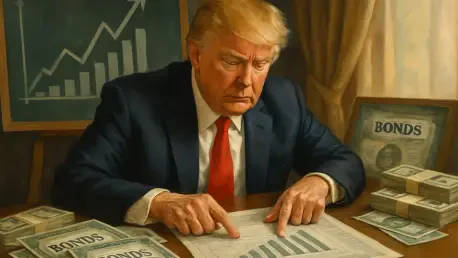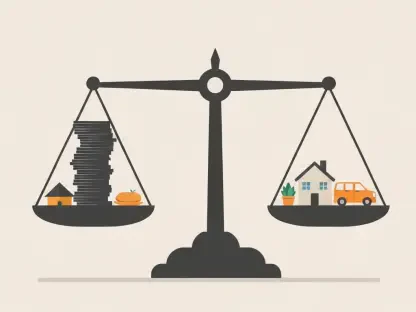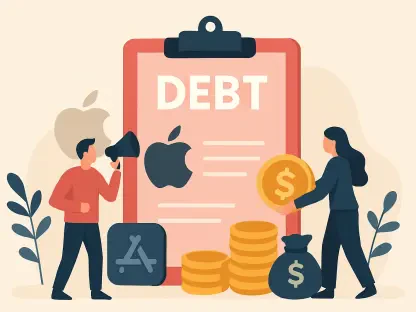What compels a billionaire president to channel over $100 million into bonds while navigating the complexities of leading a nation, and how does this reflect on his dual role under intense scrutiny? Picture this: a leader whose every financial move is analyzed, making hundreds of calculated investments amid relentless public and political pressure. Since taking office for a second term on January 20 of this year, Donald Trump has stunned observers with a massive pivot toward bond markets, igniting curiosity about the strategy behind such a significant shift in wealth management. This financial maneuver, revealed through recent disclosures, offers a rare glimpse into the intersection of power, money, and policy.
The Weight of a President’s Portfolio
Beyond personal wealth, Trump’s bond investments carry implications that ripple through political and economic landscapes. A filing with the U.S. Office of Government Ethics on August 12 of this year disclosed over 600 individual bond purchases, totaling more than $100 million. This isn’t just about numbers; it’s about a sitting president engaging with sectors like finance and technology, often shaped by federal decisions, raising questions of transparency and potential conflicts of interest. The scale of these investments underscores the need to examine how personal financial strategies align with public responsibility.
The public’s concern isn’t unfounded, given the overlap between policy influence and industries tied to these bonds. With holdings in corporate giants and local government debt, the stakes extend beyond Trump’s personal gain to how such investments might be perceived in the context of regulatory changes. This moment demands a closer look at how a leader balances immense power with a sprawling financial empire, setting the stage for deeper analysis of intent and impact.
Dissecting a Diverse $100M Bond Empire
Trump’s bond portfolio reveals a deliberate mosaic of investments across multiple sectors, reflecting a calculated approach to risk management. Corporate bonds form a significant chunk, with stakes in major players like Citigroup, Morgan Stanley, Meta, and UnitedHealth Group, pointing to a preference for established, stable entities. These choices suggest a focus on reliability over speculative ventures, painting a picture of cautious financial planning.
Beyond corporations, the portfolio includes state and municipal bonds, covering local government debt and utilities such as gas districts. This spread into community-based assets indicates an effort to balance exposure, tapping into less volatile markets. Additionally, the sectoral diversity—spanning finance, tech, healthcare, and retail—demonstrates a strategy to avoid over-reliance on any single industry, as confirmed by the detailed ethics disclosure.
Such diversification isn’t accidental; it aligns with a broader trend among high-net-worth individuals seeking stability in uncertain times. With over $1.6 billion in total assets and $600 million in income from varied sources like cryptocurrencies and golf properties, as reported in a June disclosure this year, Trump’s bond investments appear as a piece of a larger, intricate financial puzzle. This breakdown highlights a clear intent to safeguard wealth through varied, high-quality holdings.
Voices of Expertise on a Prudent Approach
Analyst John Canavan from Oxford Economics offers a grounded perspective on Trump’s financial moves, describing the bond selections as “prudent” due to their high-quality, highly rated nature. “These aren’t speculative bets; they’re a shield against volatility,” Canavan notes, emphasizing the conservative tilt of the portfolio. This insight suggests that Trump’s strategy prioritizes protection over aggressive growth, a notable choice for someone with such vast resources.
Adding to this, a senior White House official clarifies the operational distance between Trump and these decisions, stating that a third-party financial institution manages the investments in strict compliance with federal ethics laws. “There’s no direct involvement; it’s structured to avoid any perception of influence,” the official asserts. This separation aims to address public skepticism, reinforcing that the strategy is curated without personal bias or political interference.
These perspectives from experts and officials provide a layered understanding of the motivations at play. While questions about conflicts linger due to Trump’s extensive business history, the emphasis on third-party management and high-grade bonds offers a counterpoint to concerns, framing the investments as a disciplined, risk-averse plan. This blend of commentary adds depth to the narrative of a president navigating wealth under a microscope.
Ethical Edges and Public Perception
The specter of conflict of interest looms large over Trump’s financial dealings, given his dual role as a political leader and business magnate. Although the bond purchases show no direct evidence of impropriety, the sheer scope of his wealth—spanning trusts managed by family and diverse income streams—fuels ongoing debate about ethical boundaries. The decision to place companies in a trust overseen by his children reflects an attempt to mitigate criticism, yet public scrutiny persists over potential policy impacts.
This tension isn’t new, but the bond investments bring it into sharp focus, especially with holdings in sectors like tech and finance that often intersect with federal regulation. For instance, deregulation in financial markets could indirectly benefit certain corporate bonds in the portfolio, even if managed externally. This dynamic keeps the conversation alive about how much separation is truly possible for a figure whose personal and political spheres are so intertwined.
Navigating this landscape requires more than just legal compliance; it demands transparency to maintain trust. While the ethics filings provide a window into Trump’s financial world, they also highlight the challenge of fully detaching from perceptions of influence. This aspect of the story underscores a broader societal question about the expectations placed on leaders with significant private interests.
Lessons from a Billionaire’s Bond Blueprint
For those inspired by Trump’s financial tactics, several principles emerge that can be adapted to personal investment strategies, regardless of scale. Diversifying across sectors stands out as a key takeaway—spreading risk by investing in bonds from varied industries like finance and utilities, much like Trump’s approach, can be achieved through accessible tools such as bond funds or ETFs. This method helps cushion against market swings in any one area.
Another lesson lies in prioritizing quality over quantity; focusing on high-rated bonds mirrors the stability seen in Trump’s selections and offers a buffer in turbulent times. Investors can research ratings through agencies like Moody’s or S&P to guide decisions. Additionally, leveraging professional management, akin to Trump’s use of third-party advisors, ensures decisions remain objective and aligned with ethical standards, a practical step for anyone concerned about bias or conflicts.
These strategies translate complex, large-scale moves into actionable steps for everyday investors. Whether managing modest savings or substantial assets, the emphasis on balance, quality, and delegation provides a roadmap for building resilience. This perspective shifts the narrative from mere observation of a billionaire’s choices to empowerment, offering tools to navigate personal financial goals with similar foresight.
Reflecting on a Strategic Financial Legacy
Looking back, Trump’s $100 million bond venture stood as a defining moment in blending political stature with financial acumen. The deliberate diversification across corporate, state, and municipal bonds showcased a cautious yet expansive approach to wealth preservation. Managed by external entities, these investments reflected a conscious effort to uphold ethical standards amid relentless public scrutiny.
Moving forward, the broader implications of such financial strategies urged a reevaluation of how leaders with vast personal stakes could maintain transparency. For investors and policymakers alike, the challenge became ensuring that mechanisms like third-party oversight evolved to address emerging complexities. This saga prompted a call for stronger dialogue on balancing power and profit in the public sphere.
Ultimately, the lessons drawn from this chapter extended beyond one individual, encouraging a collective push toward clearer guidelines and accountability. As financial landscapes continued to intersect with governance, the focus shifted to crafting frameworks that safeguarded trust while allowing strategic innovation. This enduring conversation promised to shape how future leaders and citizens approached the delicate dance of wealth and responsibility.









